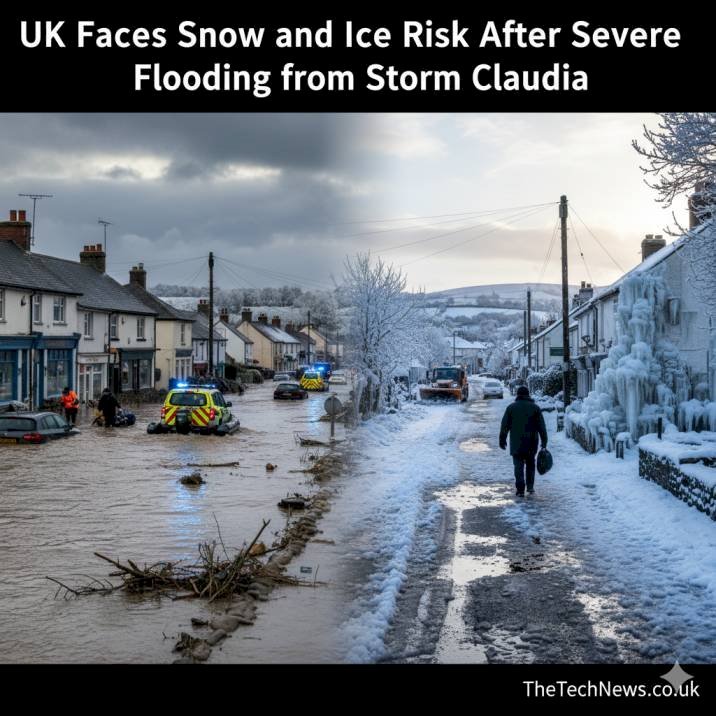UK Faces Snow and Ice Risk After Severe Flooding from Storm Claudia
The UK faces a dual weather crisis as flood-hit communities now prepare for an Arctic cold snap bringing snow, ice and health alerts across northern and eastern regions.

The UK is facing a dual weather emergency as an Arctic cold snap bringing the risk of snow, ice and freezing temperatures follows immediately after severe flooding caused by Storm Claudia over the past weekend. Communities across Wales and parts of England are still recovering from widespread flood damage, with river levels remaining high and several flood warnings still in force. The sudden shift from heavy rainfall to sub-zero temperatures has triggered cold weather health alerts, adding further challenges for residents already dealing with disruption.
Flood-hit areas struggle with recovery
Storm Claudia brought intense and prolonged rainfall, resulting in major flooding across Wales and surrounding regions. Parts of South East Wales and Gwent recorded more than 80 mm of rainfall in just 12 hours, close to 60 percent of the area’s average rainfall for the entire month of November. Monmouth was among the worst affected towns, where the River Monnow overflowed, causing homes, businesses, roads and essential services to be submerged. Areas in Worcestershire and other river-side communities also experienced significant disruption and damage.
Emergency services continue to work on rescue operations, evacuations and welfare checks. Monmouth remains under a major incident declaration, while agencies including Natural Resources Wales and the Environment Agency monitor river levels and manage flood defences. Dozens of flood warnings and alerts remain active as the full extent of the damage is still being assessed.
Cold snap brings new risks
As flood recovery efforts continue, a surge of Arctic and Scandinavian air has moved into the UK, pushing temperatures well below seasonal averages. The Met Office has issued cold weather health alerts until Friday, affecting parts of northern and eastern England including the East Midlands, West Midlands, Yorkshire and Humber, North East and North West regions.
Temperatures have already dropped to lows of around -7°C in rural Scotland and the Highlands, and frost is expected to form widely. Snow showers and icy conditions are forecast mainly in northern and eastern areas, which could further complicate travel, emergency response and clean-up operations.
Increased concern for vulnerable groups
The UK Health Security Agency has warned that elderly people, those with long-term illnesses and homeless residents face a higher risk from the cold spell, especially if flood-related damage has affected living conditions or heating systems. Local councils and charities are providing warm hubs, temporary accommodation and support services to help those at risk.
Transport and infrastructure pressures
Travel disruption is likely as standing floodwater freezes, increasing the risk of black ice on roads. Rail and air transport may also see delays due to icing and poor visibility. Power cuts and burst pipes remain a concern, particularly in buildings already weakened by flooding. Residents are being advised to limit non-essential travel during icy periods and take steps to protect homes and heating systems.
Official guidance and safety information
Officials are urging the public to follow updates from the Met Office, UK Health Security Agency, Environment Agency and local councils. Advice includes dressing warmly, checking on neighbours and staying up to date with local weather forecasts. The Environment Agency continues to warn that flood risk remains high near rivers and tributaries, even if rainfall has eased.
Climate insight
Weather experts note that the rapid shift from heavy rain to freezing temperatures reflects increasingly volatile weather patterns affecting the UK. This trend aligns with long-term climate projections, highlighting the need for strengthened resilience and preparedness planning.
Communities show resilience
Images and testimonies from affected areas illustrate the ongoing difficulty residents are facing, with flood damage, cold weather and recovery work all happening at once. Relief efforts are ongoing but conditions remain challenging.
About TheTechNews.co.uk
thetechnews.co.uk is a UK-based digital news platform providing accurate and informative reporting across technology, science, environment and public affairs. The site focuses on verified information and expert-led coverage to keep readers informed about current developments across the UK and beyond.
Frequently Asked Questions (FAQs)
1. Why is the UK experiencing a cold snap after recent flooding?
The UK is facing a cold snap because Arctic and Scandinavian air has moved south across the country shortly after Storm Claudia brought heavy rain. This rapid change in weather is the result of shifting pressure systems.
2. Which areas in the UK are most at risk of snow and icy conditions?
Northern and eastern regions, including Scotland, North East England, Yorkshire and Humber, and parts of the Midlands, are currently at the highest risk of snow and icy road conditions.
3. Which areas were most affected by the flooding from Storm Claudia?
South East Wales, Gwent, Monmouth, and parts of Worcestershire were among the most affected areas due to intense rainfall and rivers overflowing.
4. Are flood warnings still active?
Yes. Multiple flood warnings and alerts remain active as river levels are still high. Residents should check the Environment Agency or Natural Resources Wales for real-time updates.
5. How cold could temperatures get during this cold spell?
Some rural parts of Scotland and the Highlands have already recorded temperatures as low as -7°C, with frost and icy surfaces expected in several regions.
6. Who is most vulnerable during this dual weather crisis?
Elderly people, those with long-term medical conditions, flood-affected families, and homeless individuals face the highest risk due to exposure to cold and damaged living conditions.
7. Can the cold weather make the flooding worse?
Yes. Standing water can freeze, creating black ice, blocked drains and damage to pipes and properties, leading to extended disruption even after floodwaters recede.
8. What safety steps should residents take during the cold snap?
Residents should stay updated via official warnings, avoid unnecessary travel, protect pipes, dress warmly, check heating systems, and look out for vulnerable neighbours.
9. Could these extreme weather events be linked to climate change?
Experts say that increasing temperature fluctuations, intense rainfall and sudden cold snaps align with long-term climate change patterns affecting the UK.
10. Where can people check real-time weather and flood alerts in the UK?
Residents can monitor updates through the Met Office, Environment Agency, Natural Resources Wales and local council alert systems.

 AnniWeston
AnniWeston 














